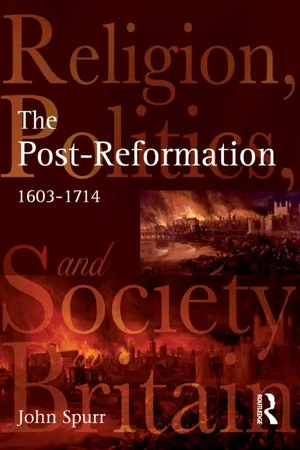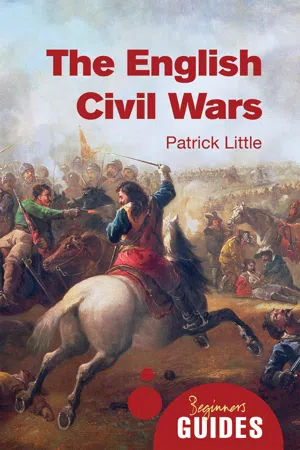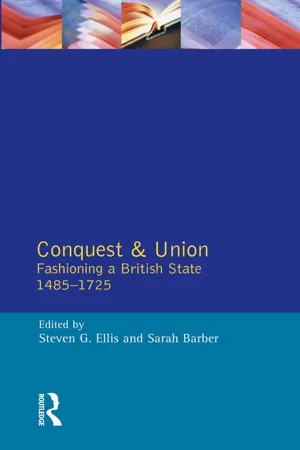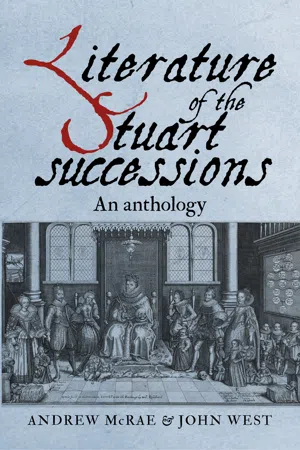History
Commonwealth of England
The Commonwealth of England was a republic that existed from 1649 to 1660, following the execution of King Charles I. It was led by Oliver Cromwell and the Parliamentarians, and marked a period of significant political and social change in England. The Commonwealth saw the abolition of the monarchy and the House of Lords, and the establishment of a republican government.
Written by Perlego with AI-assistance
Related key terms
5 Key excerpts on "Commonwealth of England"
- eBook - ePub
The Post-Reformation
Religion, Politics and Society in Britain, 1603-1714
- John Spurr(Author)
- 2014(Publication Date)
- Routledge(Publisher)
The godly cause had emerged from the struggle of the 1640s, a decade which, as we have seen, transformed the religious landscape of the country. Before 1640, religious conflicts had been centred on the teachings and actions of the clergy of the Church of England and on the international threat from popery. A decade later the question of liturgical conformity was irrelevant and debate on the nature of church government a sideshow since attention was focused on liberty of conscience and worship, the right of lay men (and even women) to preach, the possibility of national moral and spiritual regeneration, and the mechanisms to preserve parish-based religion. Popery remained a threat, but there was now a real possibility that the English would take the fight to the Roman Catholics and face them on their own European territory. The godly seized their moment. The failure to establish a new national church or to reach a political settlement in the later 1640s paved the way for a decade of largely unchecked religious experimentation and speculation. The number of those who joined the sects may have been small, but the sense of spiritual and intellectual emancipation was widespread. To some, this was a heady freedom; to others, it was a corrosive attack on certainty and order. The later 1640s and the 1650s are the key years in our story, the years in which religious pluralism took root and became an ineradicable fact of English life. They were also years in which the English left their stamp on Ireland and Scotland.The Commonwealth
On 19 May 1649 England was declared ‘a Commonwealth and Free State’ in which supreme authority rested with ‘the representatives of the people in Parliament … without any King or House of Lords’. This most unlikely republic had a slow birth: the Commons had only resolved to abolish monarchy as ‘unnecessary, burdensome and dangerous to the liberty, safety and public interest of the people’ a week after the King's head was cut off; it took another five weeks to pass acts abolishing the monarchy and House of Lords. Perhaps this just goes to show how little planning had gone into the removal of Charles I; it certainly reveals the lack of ideological republicanism in mid-seventeenth-century England. So familiar was kingship and so alien was republicanism to most people that Kelsey has described this as a period of ‘unkingship’.2The new Commonwealth had to clothe its nakedness in the fig leaf of known forms, familiar titles and official seals, to invent an effective machinery of government and, perhaps most urgently of all, to defend itself against military threats. Whatever its propaganda, the new Parliament – the Rump – was far from representative of the people: although its membership was over 200, only 60 or 70 of these were active participants in debates and legislation. Executive authority was exercised by a Council of State made up of MPs. The common expectation that the Rump would shortly dissolve itself and hold fresh elections was soon disappointed. Rumpers were too anxious about the security of the new Republic to risk a poll. Their anxiety was apparent in the imposition of the Engagement – an oath of loyalty to the government as it was then established without King or Parliament – first on office-holders and then extended to all adult males. Politically, the Engagement was a failure, but the arguments that swirled around it and found their way into print marked an important development in political philosophy and popular attitudes – a pragmatic distinction was increasingly drawn between the obedience due to a ruler who had the legal right to sovereignty and a ruler who in fact exercised that power, a distinction which eased many consciences both in the 1650s and later. - eBook - ePub
The English Civil Wars
A Beginner's Guide
- Patrick Little(Author)
- 2014(Publication Date)
- Oneworld Publications(Publisher)
Charles, who did not share his father’s religious or political scruples, was happy to keep his options open. He held talks with a Scottish delegation in the spring of 1649, but made no firm commitments to them, while at the same time encouraging Ormond. If the Irish plan failed, he would always be able to reopen negotiations with the Presbyterians. For Charles, the English throne was the prize; the means to that end were not of great importance.Creating a British republic
In England, the dramatic events of December 1648 and January 1649 were not followed by the far-reaching revolution that some hoped for and many feared. Even the dismantling of the old system of government was very slow. It was not until 7 February 1649 that the Rump Parliament (so-called because it was only the rump or remnant of the Long Parliament) set up an executive body, to fulfil those functions traditionally performed by the king and his councillors, and, more recently, by a plethora of committees acting under parliamentary authority during the civil wars. This council of state played an important role in controlling the armed forces, and was the focus for diplomacy and foreign policy, but it was firmly under Parliament’s thumb: most of the members were MPs; they were elected by Parliament annually; and their decisions were subject to parliamentary scrutiny. The establishment of an executive was followed by a great deal of constitutional tidying up. In mid-March, acts were finally passed for the abolition of the monarchy and the House of Lords, and it was not until early May that the Rump parliament voted through another crucial measure – the act declaring England to be ‘a commonwealth and free state’. This last act perhaps typifies the halting, ad hoc nature of the ‘English Revolution’. It consisted of only 105 words, and made no mention of what the republican state might look like – except for the brief comment that it would include neither a monarch nor an upper House of Parliament.The main reason for this apparent reluctance to make positive statements about the new commonwealth was the sense of uncertainty within the Rump Parliament itself. Pride’s Purge had not only removed the Presbyterians and crypto-royalists, but it had also caused the voluntary withdrawal of a large number of less partisan MPs, shocked and dismayed by the army’s actions. In the weeks after the Purge, only around seventy MPs attended the Commons. No more than forty of these were in any sense committed republicans, including Thomas Scot, Henry Marten, and Thomas Chaloner – and by no means were all of these men friends of the army. Aware that the Rump’s legitimacy was under question, the surviving MPs were keen to persuade their former colleagues to return to the House, and gradually those opposed to the regicide – including such republican critics of the army as Sir Henry Vane and Sir Arthur Hesilrige – were coaxed back to Westminster. By February, there were further concessions, aimed at winning over the more moderate MPs secluded at Pride’s Purge, with the only condition being the signing of a ‘dissent’, disowning the Newport Treaty with the late king. Such moves certainly provided a more respectable membership of around 200 (although only around a quarter of these men were present at any one time); but it also brought in yet more conservative MPs, who were keen to limit the power of the army in the commonwealth’s affairs, and who opposed radical reform in church and state. - eBook - ePub
Conquest and Union
Fashioning a British State 1485-1725
- Steven G. Ellis, Sarah Barber(Authors)
- 2014(Publication Date)
- Routledge(Publisher)
72The vitality of politics in Ireland and Scotland had brought down Charles I. Their facility for independent action, despite Stewart attempts at integration, had caused too many fissures in the royal regime. The attempt to assert power and orthodoxy was at the heart of both royal and Cromwellian policy. It was the defeats of Scotland and Ireland that confirmed Cromwell's reputation and contributed to the fall of the Commonwealth: maintaining control over the defeated territories was vital if Cromwell was to keep his prestige. The Commonwealth had not been a dress rehearsal for Cromwellian policies. Commonwealth politicians had been more concerned to consolidate control of England: they had had a hard enough struggle to establish a national republican interest. Retrenchment was part of the package when the majority of people in all three nations believed their very existence to be illegitimate.1 This is the legacy of Samuel Gardiner, Charles Firth and the scholars of the early twentieth century. More recently, studies have appeared such as R. Ashton, English Civil War: Conservation and Revolution 1603–1649 (London, 1978); J.H. Hexter (ed.) Parliament and Liberty from the Reign of Elizabeth to the English Civil War (Stanford, Calif., 1992) ; M. Ashley, The English Civil War (London, 1974). 1952 R. Hutton, The Royalist War Effort, 1642–1646 (London, 1982); A. Hughes, Politics, Society and Civil War in Warwickshire, 1620–1660 (Cambridge, 1987); J. Morrill, Cheshire, 1630–1660: County Government and Society during the English Civil War (Oxford, 1974); D. Underdown, Somerset in the Civil War and Interregnum (Newton Abbot, 1973).3 The revision of the religious aspects of the wars has never been fully realized but a contribution has been made by P. White, Predestination, Policy and Polemic: Conflict and Consensus in the English Church from the Reformation to the Civil War - eBook - ePub
The Puritan Revolution
A Documentary History
- Stuart E. Prall(Author)
- 2020(Publication Date)
- Routledge(Publisher)
Elizabeth of England, for prevention of the same) by many wicked peopie, selling their Manors, Messuages, Lands, Tenements, Hereditaments, and other things; sometimes twice, other times thrice, four or five times over to several purchasers, for good and valuable consideration, whereby divers honest people of this Nation (who have purchased the same Leases, Rents, Annuities or charges, out of the same, for great sums of money) have been defrauded of all that which they carefully and honestly have labored for, the greatest part of their lives, and afterward lived in great misery and extremity the residue of the continuance of their time. And. other of such Purchasers by reason of such frauds and deceits, have been troubled and turmoiled, and put to great excessive charges and tedious Suits; and especially in the Courts of Chancery, or in Courts called Courts of Equity, or English Courts, many years together; and yet in the end, by the means of aforesaid, have failed of recovery or obtaining that, for which they have justly and honestly paid, or any part of their money, which they have disbursed in that behalf.4 . A DECLARATION OF THE COMMONERS OF ENGLAND TO CROMWELL [13 February 1652]The Government of a commonwealth is the uniting of the people of a Nation into one heart and mind; And blessed is that People, whose Earthly Government is the Law of Common Righteousness. When Israel was under a commonwealth’s Government, they were a tenor to all Oppressing Kings in all Nations of the World; and so will England be, if this righteous Law become our Governor: But when the Officers of Israel began to be covetous and proud, they made a breach; and then the Government was altered, and fell into the hand of Kings like other Nations, and then they fled before their Enemies and were scattered. But if we look upon the customs of the Law itself, it is the same it was in the King’s days, only the name is altered; as if the Commoners of England had paid their Taxes, Free-quarter, and shed their blood, not to reform, but to baptize the Law into a new name, from Kingly Law, to State Law; by reason whereof the spirit of discontent is strengthened, to increase more Suits of Law, than formerly was known to be; And so as the Sword pulls down Kingly power with one hand, the King’s old Law builds up monarchy with the other.. . . .And now the Commoners of England in this Age of the world are risen up in an Army, and have cast out that Invasion of the Duke of Normandy, and have won their Land and Liberties again by the Sword, if they do not suffer their Councils to befool them into slavery again upon a new account. For if so be that Kingly Authority be set up in your Laws again, King CHARLES hath conquered you and your posterity by policy, and won the field of you, though you have seemingly cut off his head. For the strength of a King lies not in the visible appearance of his body, but in his Will, Laws, and Authority. But if you remove Kingly Government and set up true and free Commonwealth’s Government, then you gain your Crown, and keep it, and leave peace to your Posterity. - eBook - ePub
Literature of the Stuart successions
An anthology
- Andrew McRae, John West(Authors)
- 2017(Publication Date)
- Manchester University Press(Publisher)
Part III: 1653 and 1658Passage contains an image
Introduction
The installation of Oliver Cromwell as Lord Protector of the Commonwealth of England, Scotland and Ireland was a key event amid one of the most unpredictable periods in British political history. On 30 January 1649, Charles I was executed after a trial in which he was condemned as a tyrant, traitor and murderer. Shortly afterwards the monarchy was abolished and a republic was declared. Cromwell, who saw the trial and execution of the King as an act of divine justice, was Lord General of the army in these years, and he led the republic’s fight against Royalist insurgency in Ireland, Scotland, and England. The ruthlessness with which he prosecuted some of these campaigns, especially in Ireland, remains controversial to this day. Victories over Charles Stuart’s forces at Dunbar on 3 September 1650 and at Worcester on the same date in 1651, however, dashed Royalist hopes of a swift Stuart restoration.From this point, attention shifted from military to political matters and in particular the question of how to secure a lasting settlement. The life of the republic was characterized by frictions between moderate MPs and the reformist zeal of the army. Frustrated by the Rump Parliament’s resistance to reform, Cromwell expelled it in April 1653. It was replaced in July by the Nominated Assembly, a group of 140 new MPs selected by Cromwell and his Council of Officers. As with the Rump before it, however, divisions between moderates and radicals over political and religious reform led to its downfall. On the morning of 12 December 1653, MPs voted to yield their authority to Cromwell. Four days later he took the title of Protector at a ceremony at Whitehall, described in the newsbook Mercurius Politicus below (III.1 ).The Protectorate faced a number of immediate challenges. England was at war with the Dutch. Royalist plots were a constant threat. The Protectorate also faced opposition from republicans and radical religious groups for whom Oliver’s acceptance of the title of Protector elevated him to a position of quasi-regal authority. This was perceived as a betrayal of everything that had been fought for in the past decade. Attacks on Cromwell proliferated, from both Royalists and republicans. He was condemned as a tyrant, mocked as a false king and ridiculed for his appearance: Cromwell’s nose was one of the most common features of satirical verse in the 1650s. But there were, equally, defences of him as an active ruler guided by providence far beyond what any king could be. As Andrew Marvell put it: ‘For to be Cromwell was a greater thing, | Than ought below, or yet above, a king’ (see III.3
Learn about this page
Index pages curate the most relevant extracts from our library of academic textbooks. They’ve been created using an in-house natural language model (NLM), each adding context and meaning to key research topics.




